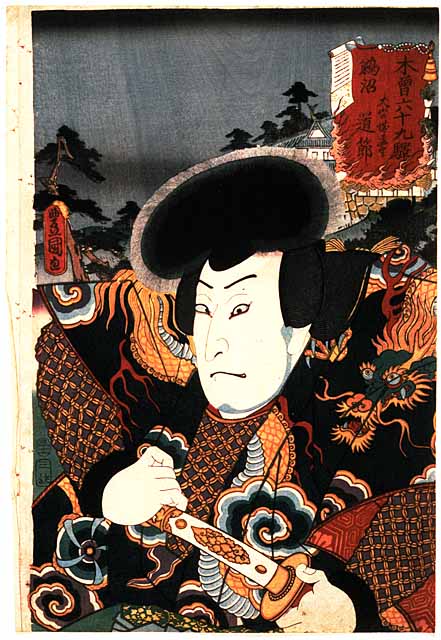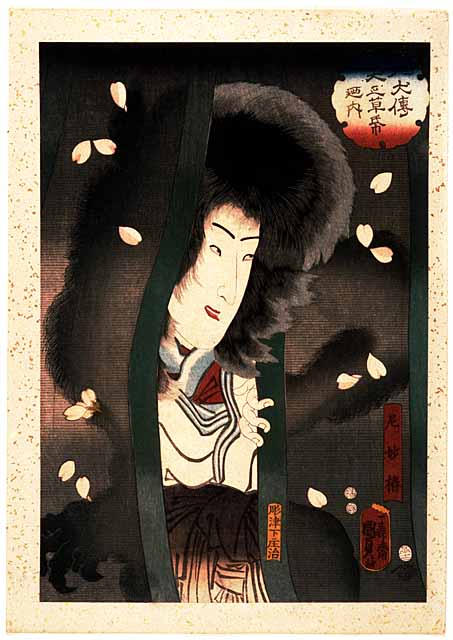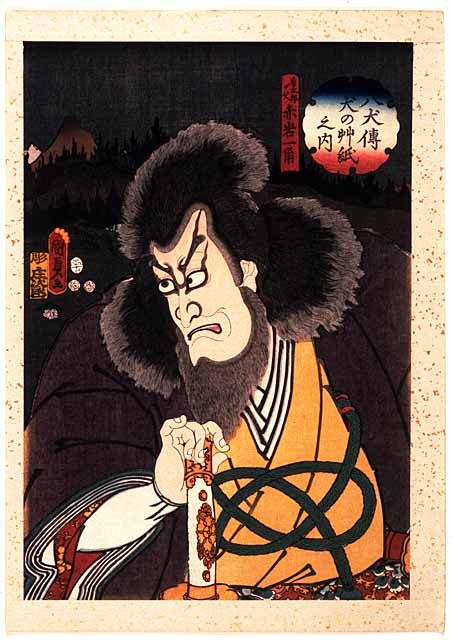
Unuma, Inuyama no shiro embo Dosetsu (Unuma, Distant view of Inuyama Castle: Dosetsu)
Kunisada 42
11/1852
Given by the Friends of the Fitzwilliam with the aid of the MGC Purchase Grant Fund and the National Art Collections Fund.
Portrait of Sawamura Sojuro V (formerly Suketakaya Takasuke III) as Inuyuma Dosetsu, with a view of Inuyama Castle on the Kiso Highway in the background, from the series Kiso rokuju-kyu tsugi (Sixty-nine Kiso Stations).
This was one of several series by Kunisada with landscape backgrounds designed to capitalise on the success of the series of prints with views of the Tokaido published in early 1852. Three prints from the Kiso series are displayed here.
Inuyama Dosetsu was one of the 8 samurai in Takizawa Baikin’s quasi-historical novel, Nanso Satomi Hakkenden (Biography of the Eight Dogs), issued over many years (1814-42) with illustrations by several artists including Kunisada. It tells the story of nine generations of the fictional Satomi clan. Each samurai represents a different samurai virtue, and has a name that includes the word for ‘dog’ (inu). The story was first adapted for Kabuki in 1834, and subsequent versions included Sakurada Jisuke III’s Satomi Hakkenden, produced in 1852 when this print was issued. Earlier in that year, Kuniyoshi designed a print of Dosetsu in his ‘Kiso Highway’ series.
Collections Record: P.65-1999

Utagawa Kunisada II (1823-80) Ama Myochin (The nun Myochin)
10/1852
Given by the Friends of the Fitzwilliam with the aid of the MGC Purchase Grant Fund and the National Art Collections Fund.
Posthumous imaginary portrait of Segawa Kikunojo V as the racoon-dog spirit Myochin, from the series Hakkenden inu no soshi no uchi (Tale of the Eight Dogs). This series is perhaps the masterpiece of the artist formerly known as Kunimasa III, who changed his name to Kunisada II after becoming Kunisada’s son-in-law and one of his best pupils.Posthumous imaginary portrait of Segawa Kikunojo V as the racoon-dog spirit Myochin, from the series Hakkenden inu no soshi no uchi (Tale of the Eight Dogs). He sometimes collaborated on prints with Kunisada, as in the print of Goro Tokimune
Collections Record: P.68-1999

Utagawa KUNISADA II (1823-80) Kakutaro ga chichi Akaiwa Ikkaku (Akaiwa Ikkaku, father of Kakutaro)
10/1852
Given by the Friends of the Fitzwilliam with the aid of the MGC Purchase Grant Fund and the National Art Collections Fund.
Retrospective portrait of Ichikawa Hakuen (Danjuro VII) as Akaiwa Ikkaku, from the series Hakkenden inu no soshi no uchi (Tale of the Eight Dogs). Another print from the series is displayed alongside.
The story comes from Takizawa Baikin’s quasi-historical novel, Nanso Satomi Hakkenden (Biography of the Eight Dogs), issued over many years (1814-22, 1827-33, 1835-42) with illustrations by several artists including Kunisada. The novel tells the story of nine generations of the fictional Satomi clan, and of eight samurai, each of whom represents a different samurai virtue and has the word for ‘dog’ (inu) as part of his name. The story was adapted for Kabuki for the first time in 1834, with numerous subsequent versions, including Sakurada Jisuke III’s Satomi Hakkenden, produced in 1852, when this series was issued. A month later Kunisada issued a print of one of the eight samurai in his series Kiso rokuju-kyu tsugi (Sixty-nine Kiso Stations).
Collections Record: P.67-1999



